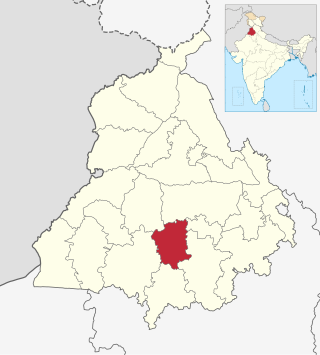
India is the most populous country in the world with one-sixth of the world's population. According to estimates from the United Nations (UN), India has overtaken China as the country with the largest population in the world, with a population of 1,425,775,850 at the end of April 2023.

Gurdaspur district is a district in the Majha region of the state of Punjab, India. Gurdaspur is the district headquarters. It internationally borders Narowal District of Pakistani Punjab, and the districts of Amritsar, Pathankot, Kapurthala and Hoshiarpur. Two main rivers Beas and Ravi passes through the district. The Mughal emperor Akbar is said to have been enthroned in a garden near Kalanaur, a historically important town in the district. The district is at the foothills of the Himalayas.

Bathinda district is in Malwa region of Punjab, India. The district encompasses an area of 3,385 square kilometers. By area, Bathinda district is the second-largest in Punjab, after Ludhiana district. It is bounded by Faridkot district and Moga district on the north, Muktsar district on the west, Barnala and Mansa districts on the east, and the state of Haryana on the south. Bathinda is cotton producing belt of Punjab.

Kapurthala district is a district of Punjab state in northern India. The city of Kapurthala is the district headquarters.

Faridkot district is a district lying in the South-Western part of Punjab, India with Faridkot city as the district headquarters.

Sri Muktsar Sahib district, is one of the 23 districts in the Indian state of Punjab. The capital city of district is Sri Muktsar Sahib. The district itself was historically referred as Khidrane Di Dhaab. There are 4 Tehsils in District which consists of total 234 villages. 1. Sri Muktsar Sahib 2. Lambi 3. Gidderbaha 4. Malout
This is a list of the States of India ranked in order of average number of persons in a family. This information was compiled from NFHS-3. National Family health survey (NFHS) is a large-scale, multi round survey conducted by the International Institute of Population Sciences (IIPS), Mumbai designated by the Ministry of Health and Family Welfare (MOHFW), Government of India. NFHS-3 was released on 11 Oct 2007 and the detailed survey can be viewed in the following website The average household size of India is 4.8. The lowest is 3.5 in Tamil Nadu and the highest is 5.7 in Uttar Pradesh. India has more than 32 crore households (2022).

Obesity in India has reached epidemic proportions in the 21st century, with morbid obesity affecting 5% of the country's population. India is following a trend of other developing countries that are steadily becoming more obese. Unhealthy, processed food has become much more accessible following India's continued integration in global food markets. This, combined with rising middle class incomes, is increasing the average caloric intake per individual among middle class and high income households. Obesity is a major risk factor for cardiovascular disease, and NGOs such as the Indian Heart Association have been raising awareness about this issue.
The Demographic and Health Surveys (DHS) Program is responsible for collecting and disseminating accurate, nationally representative data on health and population in developing countries. The project is implemented by ICF International and is funded by the United States Agency for International Development (USAID) with contributions from other donors such as UNICEF, UNFPA, WHO, and UNAIDS.

Barnala is one of the districts of Indian state of Punjab. It was carved out of Sangrur district, in November 2006. It is a centrally located district bordered by Ludhiana district on the north, Moga district on northwest, Bathinda district on west, Sangrur district on east and Mansa district on south. As per census 2011, Population of District Barnala is 5,96,294. Barnala boasts a significant number of colleges that offer a diverse range of educational opportunities in fields such as engineering, arts, medicine, and commerce. Furthermore, the town is renowned for its thriving industrial sector. Two main Industries: Trident Group and a large Industry producing Combines, Standard Combines were also established here.
Despite India's 50% increase in GDP since 2013, more than one third of the world's malnourished children live in India. Among these, half of the children under three years old are underweight.

Domestic violence in India includes any form of violence suffered by a person from a biological relative but typically is the violence suffered by a woman by male members of her family or relatives. Although men also suffer domestic violence, the law under IPC 498A specifically protects only women. Specifically only a woman can file a case of domestic violence. According to a National Family and Health Survey in 2005, total lifetime prevalence of domestic violence was 33.5% and 8.5% for sexual violence among women aged 15–49. A 2014 study in The Lancet reports that although the reported sexual violence rate in India is among the lowest in the world, the large population of India means that the violence affects 27.5 million women over their lifetimes. However, an opinion survey among experts carried out by the Thomson Reuters Foundation ranked India as the most dangerous country in the world for women.
The National Family Health Survey (NFHS) is an India-wide survey conducted by the Ministry of Health and Family Welfare, Government of India, with the International Institute for Population Sciences serving as the nodal agency.
Women in Punjab can also be known as Punjabans or Punjabi women. They are the female inhabitants of state of Punjab in India. They belong to diverse economic, social, cultural and caste backgrounds, but their residence in a common state gives them a shared identity. Women have made significant progress in Punjab but they still remain underrepresented in various fields due to the patriarchal structure still remaining intact in Punjabi society.









